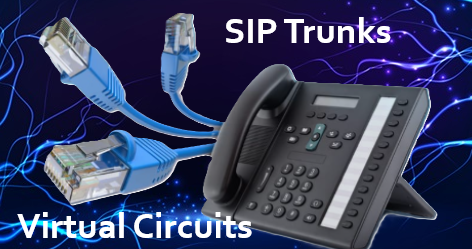
SIP Trunk Blog
SIP Trunks
8/1/20243 min read


Emerging Technology!
As a thriving business, you're always on the lookout for the next breakthrough. Whether you're a small enterprise seeking the adaptability and cost efficiency of VoIP, or a medium-sized business aiming for continuity and a variety of calling plan options, we can assist you in achieving up to 40% savings on traditional telephone services.
Session Initiation Protocol (SIP) is emerging as the universal signaling standard for real-time communications that employ VoIP (Voice over Internet Protocol). SIP allows for a smooth integration with your current on-premises phone systems through our carrier-grade voice network.
We offer you the flexibility of multiple SIP Trunk groups, complete with an unlimited number of pre-paid calling paths. Additionally, you have the option to expand by up to ten extra calling paths on-demand, enabling more effective capacity planning.
What is SIP Trunking?
SIP Trunking refers to the use of VoIP to connect your premise based phone system to the Internet. A broadband or Internet connection replaces traditional, plain-old-telephone (POTs) or Primary Rate Interface (PRI) lines, allowing your organization to communicate more efficiently with better scalability. SIP Trunking may be utilized with virtually any PBX system, including modern IP based phone systems or older styled analog systems. The older systems may require an integrated access device (IAD) to bridge the SIP connection to your PBX. Either way, SIP Trunking will bridge your company to the modern communications cloud, helping connect all office and mobile users together.
Benefits of UbiLynx Enhanced SIP Trunking
Burstability: The ability to burst above the number of pre-paid trunks or call paths on demand, automatically.
Control: As a customer, you’ll be able to make changes to the platform as you need them, including scalability, API integration, an intuitive UI, and our future-proofed platform.
Advanced Call Routing: Enables customers with advanced routing capabilities including call forwarding, and call status (away, busy, unreachable, etc.).
Multi-office Trunking and Business Continuity: Aggregate your SIP Trunks to improve business continuity between office and leverage the savings that comes with pooling and centralizing your communication needs at the enterprise level. We’ll even provide you with improved disaster recovery options so you can sleep soundly in the event of a shutdown or natural disaster.
A SIP trunk is delivered to a client over a physical internet circuit or other network connection, not as a separate physical wired circuit like traditional telephony circuits. Here's a detailed explanation:
1. Physical Internet Circuit
SIP trunks are typically delivered over an internet connection (e.g., fiber, DSL, cable).
The internet connection acts as the medium for transmitting SIP signaling and VoIP traffic.
In most cases, businesses connect their IP-enabled PBX (Private Branch Exchange) or a Session Border Controller (SBC) to the SIP trunk provider through this connection.
Dedicated internet connections, often referred to as "dedicated circuits" or "QoS-enabled circuits," are sometimes used to ensure reliable voice quality by prioritizing VoIP traffic.
2. Cloud or Hosted Connectivity
While the physical layer is the internet circuit, SIP trunks are often managed through cloud-based infrastructure by the SIP provider.
This means that the service itself is hosted in the provider's cloud, which routes calls over the internet or a private IP network to the client's on-premise equipment or cloud-based phone system.
In this case, the client interacts with a virtual SIP service rather than managing physical telephony infrastructure.
3. Direct Connection from Service Providers
In enterprise deployments, SIP trunk providers may offer private IP connectivity (e.g., MPLS circuits) directly from their network to the client's location. This option ensures enhanced security, reliability, and call quality compared to public internet.
In Short:
SIP trunks are delivered using a physical internet circuit (or sometimes private IP circuits), but the trunk itself exists as a virtual connection provided through the internet or the provider's cloud network.
Why SIP Trunks Aren't Separate Circuits:
Utilizes Existing Infrastructure:
SIP trunks operate over the same physical internet or private IP network connection used for data traffic, meaning there’s no need for a unique physical telephony line like in traditional analog or ISDN systems.
Virtual Connection:
A SIP trunk is essentially a virtual telephony service managed by the provider in their infrastructure. The "trunk" is the logical pathway for voice traffic over the network.
Flexible Delivery:
SIP trunks can be delivered via:
Public internet: Over your standard broadband or dedicated fiber connection.
Private network: Using a dedicated MPLS or similar connection provided by the service provider for enhanced QoS.
Cost-Effective and Scalable:
Because SIP trunks are virtual, businesses can scale up or down without requiring physical installation or removal of circuits.
Comparison to Traditional Phone Lines:
Traditional analog or PRI lines involve a dedicated copper or fiber line physically installed at the business for voice traffic.
SIP trunks eliminate this by combining voice and data traffic over a single internet connection, simplifying the infrastructure and reducing costs.
In summary, while a reliable internet or private IP connection is essential for SIP trunking, no additional separate wired circuit is brought into the business specifically for the SIP trunk itself.
Contact us with any questions, comments or requests at: tfarley@ubilynx.com
or Text me at: 630-696-0289

